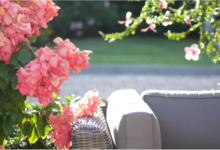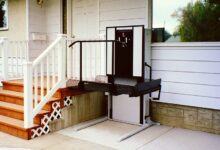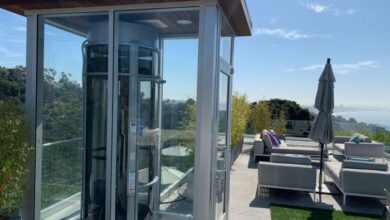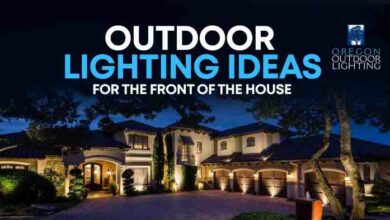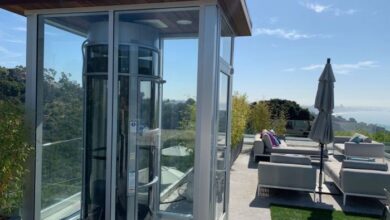Home Exterior Christmas Lights A Festive Guide
Home Exterior Christmas Lights transform houses into winter wonderlands. From classic incandescent bulbs to energy-efficient LEDs, the choices are dazzling. This guide explores various light types, planning considerations, safe installation techniques, creative design ideas, and troubleshooting tips, helping you create a spectacular holiday display.
We’ll cover everything from choosing the right lights for your home’s style to safely installing them and even troubleshooting common problems. Get ready to illuminate your holiday season with stunning exterior lighting!
Types of Home Exterior Christmas Lights
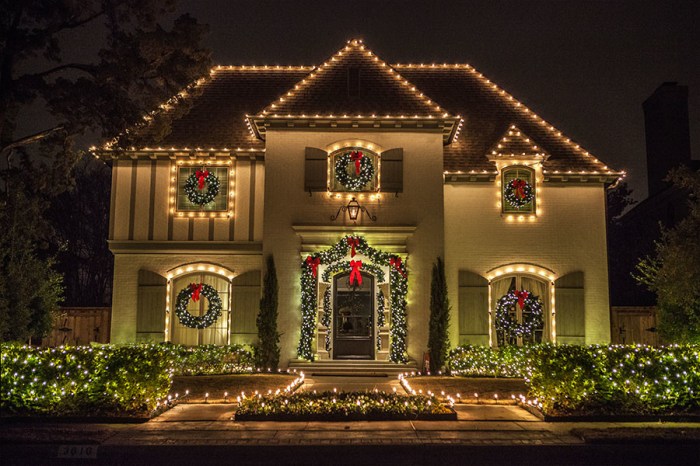
Source: hzcdn.com
Choosing the right Christmas lights for your home’s exterior can significantly impact the overall look and feel of your holiday display. The variety available can be overwhelming, so understanding the different types and their characteristics is key to making an informed decision. This section will explore the popular options, comparing their energy efficiency, lifespan, cost, and aesthetic qualities.
Incandescent, LED, and Other Light Types
Incandescent lights, the traditional choice, produce a warm, inviting glow using a filament heated by electricity. However, they are notoriously energy-inefficient and have a short lifespan, often burning out after a single season. LED (Light Emitting Diode) lights, on the other hand, are significantly more energy-efficient, lasting much longer and consuming far less electricity. They also offer a wider range of colors and brightness options.
Other technologies, while less common for exterior use, include halogen and neon lights. Halogen lights offer brighter illumination than incandescent bulbs but still consume more energy than LEDs. Neon lights, though offering unique visual effects, are typically more expensive and require specialized installation.
C7 and C9 Lights: Size and Style
C7 and C9 lights are named for their bulb diameter in eighths of an inch (7/8 inch and 9/8 inch, respectively). C7 bulbs are smaller and more delicate, while C9 bulbs are larger and bolder, creating a more substantial visual impact. Both are commonly available in incandescent and LED versions, offering a classic look suitable for traditional displays. The larger size of C9 lights allows for more visible light output, making them suitable for larger houses or areas with more distance between lights.
Net Lights and Icicle Lights: Specialized Effects
Net lights are pre-strung lights designed to drape easily over shrubs, bushes, or other irregularly shaped objects. They offer a convenient way to quickly illuminate larger areas, creating a soft, ambient glow. Icicle lights, on the other hand, hang vertically, mimicking icicles and providing a unique, cascading effect. Both net and icicle lights are predominantly available in LED versions, prioritizing energy efficiency and longevity.
| Light Type | Energy Efficiency | Lifespan | Cost | Brightness | Color Options |
|---|---|---|---|---|---|
| Incandescent | Low | Short (1 season) | Low (initially) | Moderate | Limited (typically warm white) |
| LED | High | Long (multiple seasons) | Moderate to High (initially) | Variable (high to low) | Wide range (multi-color, warm white, cool white) |
| C7 | Variable (depending on bulb type) | Variable (depending on bulb type) | Moderate | Moderate | Variable (depending on bulb type) |
| C9 | Variable (depending on bulb type) | Variable (depending on bulb type) | Moderate to High | High | Variable (depending on bulb type) |
| Net Lights | High (typically LED) | Long (typically LED) | Moderate to High | Moderate | Variable (typically multi-color or warm white) |
| Icicle Lights | High (typically LED) | Long (typically LED) | Moderate to High | Moderate | Variable (typically white or multi-color) |
Planning & Design Considerations
Planning your home’s exterior Christmas lighting display requires careful consideration of several factors to ensure a dazzling and safe outcome. The size and style of your home, along with your landscaping, will all influence the best approach to lighting placement and the overall aesthetic effect. Effective planning also involves choosing appropriate lighting techniques and accurately calculating the number of light strands needed.Factors influencing light placement significantly impact the final look of your Christmas display.
Ignoring these can lead to an uneven, underwhelming, or even unsafe display.
House Size and Architectural Style
House size directly impacts the amount of lighting needed. A large Victorian home will require significantly more lights than a small bungalow. Similarly, the architectural style dictates the best placement strategies. For instance, a traditional colonial home might benefit from evenly spaced lights outlining the roofline and windows, while a modern home might look better with strategically placed spotlights highlighting architectural details.
Consider the prominent features of your home – a large porch, tall columns, or intricate gables – and plan your lighting to accentuate these areas. A sprawling ranch style home might benefit from outlining the roofline and using spotlights to highlight bushes or trees. In contrast, a narrow townhouse might look best with vertical lines of lights.
Landscaping Considerations
Your landscaping plays a vital role in your Christmas lighting scheme. Trees, bushes, and other plants offer opportunities for creative lighting displays. Tall trees can be elegantly illuminated with uplighting, creating a magical atmosphere. Shorter bushes can be Artikeld with smaller strings of lights, or used as a base for projection lights. Consider the size and shape of your landscaping features when planning light placement.
For example, a large oak tree could support numerous strings of lights, creating a dramatic focal point, whereas smaller shrubs might only accommodate a few strands. Remember to account for pathways and driveways to ensure safe and convenient access during the holiday season. Avoid placing lights too close to flammable materials, like dry leaves or pine needles.
Lighting Techniques and Their Visual Impact, Home Exterior Christmas Lights
Different lighting techniques offer distinct visual effects.
Outlining
Outlining involves placing lights along the edges of your home, highlighting its shape and architectural details. This technique creates a clean, classic look and is suitable for most home styles. Consider using warm white or multi-colored lights for a festive atmosphere. This is particularly effective on homes with prominent architectural details, such as gables, dormers, or columns.
Imagine outlining the roofline of a Cape Cod style home with warm white LED lights—it creates a welcoming and traditional feel.
Uplighting
Uplighting directs light upwards, highlighting the architectural features from below. This technique creates a dramatic and elegant effect, especially on taller structures like trees or the sides of your house. Uplighting can also create a sense of depth and dimension, making your home appear larger and more impressive. For instance, uplighting a tall tree in your front yard with cool white LED lights can produce a stunning effect.
Downlighting
Downlighting involves directing light downwards from above. This technique is often used to illuminate walkways, driveways, or landscaping features. Downlighting can create a warm and inviting atmosphere, and it can also enhance safety by improving visibility. For example, you could use pathway lights to guide guests safely to your front door.
Step-by-Step Guide for Planning Light Placement
Planning your lighting involves several steps to ensure a cohesive and well-lit display.
- Measure Your Home and Landscaping: Carefully measure the perimeter of your house, including the roofline, windows, and other features you want to illuminate. Also, measure the height and width of trees and bushes that you plan to decorate. Accurate measurements are crucial for determining the amount of lighting needed.
- Sketch a Plan: Create a simple sketch of your home and landscaping, noting the placement of windows, doors, trees, and other key features. This will help you visualize the placement of your lights and ensure a balanced design.
- Choose Your Lighting Techniques: Decide which lighting techniques you will use (outlining, uplighting, downlighting) based on your home’s style and landscaping. Consider the overall mood you want to create – festive, elegant, or whimsical.
- Determine the Number of Light Strands: Based on your measurements and chosen techniques, calculate the number of light strands you will need. Most light strand packages provide information on the length of each strand. Add extra to account for overlaps and any unexpected needs.
- Plan Light Placement on Your Sketch: Mark the placement of your light strands on your sketch, ensuring even coverage and a balanced design. Consider the direction of light and the overall effect you want to achieve.
- Purchase Your Lights: Once you have a plan, purchase your lights. Consider the type of bulbs (LED, incandescent), color, and wattage.
Remember that safety is paramount. Always use outdoor-rated lights and extension cords, and never overload circuits.
Installation Methods & Safety
Installing Christmas lights safely and effectively is crucial for both the longevity of your decorations and the safety of your family and home. Proper installation involves understanding different light types, using the right tools and techniques, and prioritizing electrical safety. This section will guide you through the process, highlighting key safety precautions.
Securing Lights to the House
Several methods exist for safely attaching Christmas lights to your home’s exterior. For houses with gutters, you can use gutter clips designed specifically for holiday lighting. These clips usually come in various sizes and are easy to install, preventing damage to your gutters. For areas without gutters, plastic hooks or clips that adhere to the siding can be used.
Ensure these are rated for outdoor use and are applied carefully to avoid scratching or damaging the paint. For brick or stone exteriors, you may need to use small nails or screws, but always use appropriate fasteners to avoid cracking the material. Remember to remove all fasteners carefully after the holiday season to prevent damage and potential hazards.
Avoiding Electrical Hazards
Electrical safety is paramount when installing outdoor lighting. Never overload circuits by connecting too many strands of lights. Always check the amperage rating of your extension cords and ensure they are rated for outdoor use and are in good condition (no cracks or fraying). Using Ground Fault Circuit Interrupters (GFCI) outlets is essential for outdoor installations. GFCI outlets detect ground faults and quickly shut off power, preventing electric shocks.
Never use indoor extension cords or lights outdoors; they are not designed to withstand the elements and pose a significant fire hazard. Before beginning any installation, make sure to turn off the power at the breaker box to the circuit you’ll be using.
Connecting Light Strands
Connecting light strands correctly ensures continuous and even illumination. Most strands have end connectors that allow for easy connection. Make sure the connectors are firmly secured and that the connections are weatherproof. If using multiple strands, start with the first strand plugged into a GFCI outlet, and then connect subsequent strands in series. Avoid overloading any single circuit by exceeding the maximum wattage rating specified on the extension cord and the lights themselves.
If you’re unsure about the total wattage, it’s best to err on the side of caution and use fewer lights or multiple circuits. Regularly check the connections throughout the holiday season to ensure they remain secure and that no wires are exposed.
Using Appropriate Extension Cords
Choosing the right extension cord is critical for preventing electrical hazards. Outdoor extension cords must be rated for outdoor use and be heavy-duty enough to handle the wattage of your lights. Look for cords marked with a “W” for wet location use. Never use damaged or frayed extension cords, as these pose a serious fire risk. Ensure the cord is long enough to reach the outlet without being stretched taut.
A taut cord can damage the insulation and create a potential hazard. Avoid running cords across walkways or areas where they might be damaged by foot traffic or lawn equipment. Consider using cord covers or protectors to keep cords concealed and protected from the elements.
Creative Lighting Designs & Themes: Home Exterior Christmas Lights
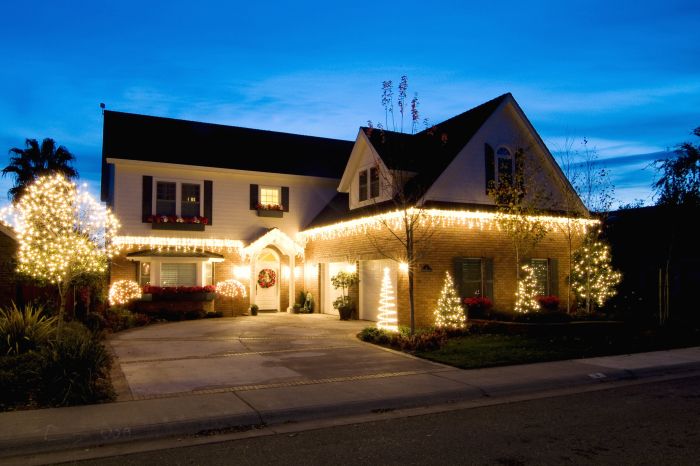
Source: thespruce.com
Choosing the right Christmas lighting design can dramatically enhance your home’s curb appeal and create a festive atmosphere. The key is to select a style that complements your home’s architecture and reflects your personal taste. Consider the overall aesthetic you want to achieve, whether it’s classic elegance, modern minimalism, or rustic charm.This section explores various creative lighting designs and themes to inspire your holiday decorating.
We’ll examine how different lighting styles can transform various home styles and suggest ways to integrate other decorative elements for a truly stunning display.
Creative Lighting Designs for Different Home Styles
The style of your home significantly influences the most effective lighting design. A traditional home might benefit from a classic, warm glow, while a modern home could embrace a more minimalist, sleek approach. A rustic home could be enhanced with a charming, slightly more whimsical lighting scheme.
- Traditional Homes: Traditional homes often look best with warm white or incandescent lights, possibly incorporating icicle lights or outlining the roofline with classic C7 or C9 bulbs. Imagine a stately colonial home adorned with strings of warm white lights outlining the roofline and windows, complemented by larger C9 bulbs in a rich red or deep green hanging from the eaves.
The overall effect is elegant and timeless.
- Modern Homes: Modern homes benefit from clean lines and a more minimalist approach. Consider using LED strip lights to highlight architectural features or create a subtle, ambient glow. Imagine a sleek, modern home with LED strip lights subtly outlining the windows and doors, creating a soft, cool white glow. This creates a sophisticated and contemporary feel without being overly flashy.
- Rustic Homes: Rustic homes lend themselves to a more whimsical and charming lighting scheme. Consider using string lights with warm, amber tones, perhaps incorporating some flickering LED candles for a cozy, inviting ambiance. Picture a charming cabin-style home with strings of warm white and amber lights draped across the porch and wrapped around trees in the yard. The overall effect is cozy and inviting, creating a sense of warmth and nostalgia.
Popular Christmas Lighting Themes
Many popular Christmas lighting themes cater to diverse tastes and styles. Choosing a theme helps unify your decorations and creates a cohesive look.
- Traditional Red and Green: This classic theme uses red and green lights, often combined with traditional ornaments and decorations. This creates a festive and classic holiday look.
- Winter Wonderland: This theme uses cool-toned white and blue lights to create a magical, icy landscape. Think shimmering icicle lights and strategically placed spotlights to highlight snow-covered landscaping (if applicable).
- Minimalist White: This elegant theme utilizes only white lights, creating a sophisticated and understated look. This approach allows the architecture of the home to take center stage.
- Rainbow Lights: This fun and vibrant theme uses a variety of colored lights to create a playful and cheerful atmosphere. This can be particularly appealing for families with children.
Incorporating Other Decorative Elements
Adding other decorative elements can significantly enhance the visual impact of your Christmas lights. Strategic placement of wreaths, garland, and ornaments can tie everything together seamlessly.
- Wreaths: Hang wreaths on the front door, windows, and even along the fence line to add pops of color and texture. Consider using wreaths that complement the colors of your lights.
- Garland: Drape garland along the roofline, railings, or around trees to add a lush, festive touch. Choose garland that matches or complements the style of your lights.
- Ornaments: Incorporate larger, weatherproof ornaments into your lighting display. Hang them from trees, bushes, or even from the eaves of your house. Consider using ornaments that reflect the light for added sparkle.
- Other elements: Consider adding other elements such as ribbon, bows, or even projected images to further enhance your display. The possibilities are endless!
Maintenance & Troubleshooting
Proper care and maintenance of your Christmas lights are crucial for ensuring their longevity and a dazzling display year after year. Neglecting these aspects can lead to premature failure, requiring costly replacements and potentially disrupting your holiday cheer. This section Artikels best practices for storage, identifies common problems, and provides solutions for troubleshooting issues.
Storing Christmas Lights
Storing Christmas lights correctly is essential to prevent damage and extend their lifespan. Improper storage can lead to tangled wires, broken bulbs, and even short circuits. To avoid these problems, begin by carefully removing the lights from your home’s exterior. Gently untangle any knots or twists. Inspect each strand for any damaged bulbs or frayed wires; replace or repair these before storing.
Once inspected, you can neatly coil the lights, using a large zip tie or twist tie to secure the coil. Avoid tightly winding the lights around your hand as this can stress the wiring. For added protection, consider placing each coil in a labeled, sealed plastic bag or a dedicated storage container to protect them from moisture and dust.
This organized approach ensures your lights are ready for the next holiday season.
Common Problems and Troubleshooting
Several issues can arise during the installation or use of outdoor Christmas lights. These problems often stem from simple causes and are usually easily resolved.
Blown Bulbs
Blown bulbs are a common occurrence. Identifying a blown bulb is straightforward; it simply won’t light up. The solution is equally simple: replace the bulb. Most strands of Christmas lights are designed with replaceable bulbs. Always ensure the replacement bulb is the correct voltage and wattage to avoid further damage.
Replacing a single bulb often resolves the problem. If multiple bulbs are blown in close proximity, it may indicate a more significant problem such as a short circuit or a power surge.
Faulty Connections
Loose or damaged connections are another frequent cause of malfunctioning lights. Inspect the plugs and connectors carefully, looking for any signs of damage or corrosion. If a connection appears loose, try gently tightening it. If the connection is damaged, you may need to replace the entire section of the light string, or if possible, carefully solder the connection (if you have the skill and equipment).
Always remember to disconnect the power before handling any electrical components.
Flickering Lights
Flickering lights can be caused by several factors. A loose connection, a partially blown bulb, or even a problem with the power supply can lead to flickering. Start by checking all connections, replacing any blown bulbs, and making sure the power supply is functioning correctly. If the flickering persists, it may indicate a more serious problem requiring professional attention.
Overloading a circuit can also cause flickering, so ensure your total power draw doesn’t exceed the circuit’s capacity.
Lights Not Working at All
If an entire strand of lights fails to illuminate, the problem might be a blown fuse in the power supply or a faulty plug. Check the fuse and replace it if necessary. If the fuse keeps blowing, it indicates a more significant short circuit in the wiring. If the plug is damaged, replacement might be necessary. Again, disconnect the power before making any repairs or replacements.
Visual Representation of Lighting Schemes
Choosing the right Christmas lights and placement dramatically impacts your home’s festive appeal. Visualizing the final effect beforehand is crucial for achieving a cohesive and stunning display. Let’s explore two distinct examples.
Victorian Home with Warm White Icicle and Artikel Lights
Imagine a grand Victorian home, its dark wood siding a rich backdrop for a warm, inviting light display. The roofline is delicately Artikeld with strands of warm white LED outlining lights, creating a crisp, defined silhouette against the night sky. These lights are evenly spaced, maintaining a consistent glow without being overly dense. From the eaves, cascading strands of warm white LED icicle lights hang down, varying in length to create a dynamic, textured effect.
The density of the icicle lights is greater near the corners and doorways, drawing the eye to these architectural features. The overall effect is one of elegant charm and classic holiday splendor. The warm white light creates a cozy and welcoming ambiance, enhancing the home’s inherent architectural details and creating a magical, almost fairytale-like atmosphere. The lights are not so bright as to be overwhelming, but rather subtly enhance the home’s beauty.
Modern Farmhouse with Cool White LED Strip Lights and Spotlights
In contrast, consider a modern farmhouse with clean lines and a minimalist aesthetic. Here, cool white LED strip lights are strategically integrated into the architectural details. These lights are recessed into the soffits and along the edges of the roofline, providing a subtle, even illumination. The density is consistent, avoiding any harsh contrasts. Strategically placed spotlights, also using cool white LEDs, highlight key architectural elements such as window frames, the front door, and any unique stone or wood features.
These spotlights are carefully aimed to accentuate textures and shadows, creating a modern, sophisticated look. The overall effect is clean, crisp, and contemporary. The cool white light offers a more modern and sleek aesthetic, perfectly complementing the farmhouse’s design. The combination of strip lights and spotlights produces a balanced illumination, showcasing the home’s architectural details without overwhelming the design.
Last Point
Creating a breathtaking Christmas light display is achievable with careful planning and the right information. By understanding the different types of lights, implementing safe installation practices, and embracing creative design ideas, you can transform your home’s exterior into a festive masterpiece that brightens the neighborhood and celebrates the holiday spirit. So, gather your supplies, get creative, and let your home shine!
FAQ Corner
How long do exterior Christmas lights typically last?
It varies greatly depending on the type of bulb (LEDs generally last much longer than incandescent) and how well they are stored. LEDs can last for several seasons, while incandescent bulbs might only last one.
Can I use indoor Christmas lights outside?
No, indoor lights are not designed for outdoor use and are not weather-resistant. Using them outdoors can be a fire hazard.
What’s the best way to dispose of old Christmas lights?
Check with your local recycling center or waste management company for proper disposal guidelines. Some retailers also offer recycling programs for electronics.
How can I prevent my lights from getting tangled?
Carefully wrap lights around cardboard tubes or use designated storage containers designed for light strings to keep them organized and tangle-free.
Are there any energy-saving tips for exterior Christmas lights?
Use LED lights, which consume significantly less energy than incandescent bulbs. Also, use timers to control when the lights are on, reducing energy waste.
